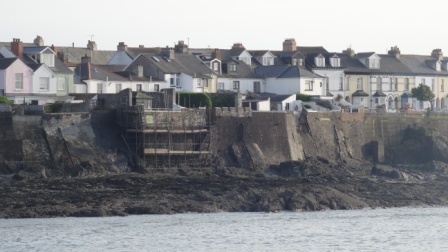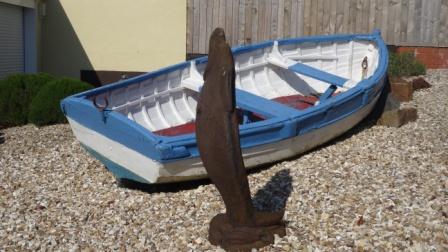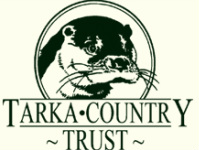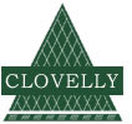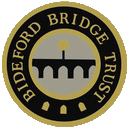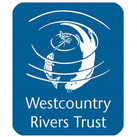Schooner on the Rocks & Puffin in the Garden.
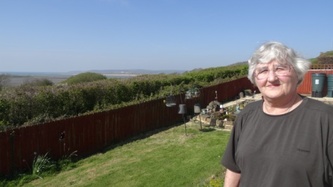 Ann Wells with the Taw & Torridge in the background
Ann Wells with the Taw & Torridge in the background
Ann Wells
from Appledore contacted Boat Stories and invited me to see her ten-foot, clinker-built punt, ‘Puffin’ which her father
bought for her when she was ten years old. When I arrived, Ann now 70, took me straight
round to the back of the house and the astonishing view. Ann and her husband George can see a wide
sweep of Bideford Bay from Hartland Point in the west, round to Baggy Point in the
East. Entertainment is provided by the comings and goings of various boats and
ships –most of which Ann recognises. That same day they’d watched the Irish
fisheries patrol vessel, Samuel Beckett (built at Appledore shipyard)
undergoing sea trials. Ann can also see the mouth of the river where she fished
in Puffin, alone – because her father didn’t want the responsibility should
anything happen to another child. She was told never to go beyond the
confluence of the two rivers or near the notorious Bideford Bar. Ann dug
crabs for bait, made her own fishing lines and spent hours pottering about on
the water.
|
Occasionally Ann’s father joined her in the Puffin, using his daughter as ‘cover’ to go salmon poaching. Walter Ford had three other boats and one of the coveted salmon netting licenses on the river. But salmon fishing was strictly regulated and for families like Ann’s, winters were hard. One sympathetic bailiff used to give them the all clear now and again. ‘It was like the regatta out there,” Ann said, laughing merrily. “Country folk had their hares and pheasants and we had our fish.” Other nights when the bailiff was on duty, warning lights followed his progress around the village. Residents of Irsha street allowed poachers “to climb up the ladders directly from the beach and emerge through the front door. There’d be a gift of salmon on the doorstop in the morning."
|
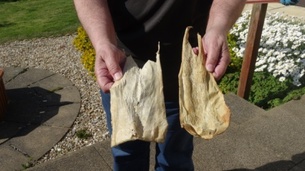 skin of sole used to make bait
skin of sole used to make bait
Ann tells a story, passed on by her mother, who had a visit from the inspector, between the wars, while Walter was out poaching. Her Mum began sewing his leather sea boots, telling the inspector her husband was out searching for work, praying he wouldn’t walk in with a salmon. The visitor was so impressed that she was ‘making things do’ he promised them an extra two shillings a week benefit. Later Ann became a theatre nurse. After a night shift, the surgeons would catch her with a wink, “we’ve got a dinner party coming up – any chance of some red hake?”
Ann also learned to fish ‘beyond the bar’ catching plaice, skate and turbot with her father. “We had so much turbot we used to grumble at eating turbot sandwiches.” Walter Ford knew how to fish,” Ann told me proudly, “and everyone else knew it”. She described how he would note three marks over the cod pits, “one from the top of Westward Ho, one from Appledore and the third in Instow which was always a cow, so no one knew where it was. Not even me, and then I couldn’t say nothing.” On the way home, fishermen would ask whether they’d caught anything. ‘Not a bloody bite,’ her Dad shrugged crossly – with the boat weighed down with fish!
Ann also learned to fish ‘beyond the bar’ catching plaice, skate and turbot with her father. “We had so much turbot we used to grumble at eating turbot sandwiches.” Walter Ford knew how to fish,” Ann told me proudly, “and everyone else knew it”. She described how he would note three marks over the cod pits, “one from the top of Westward Ho, one from Appledore and the third in Instow which was always a cow, so no one knew where it was. Not even me, and then I couldn’t say nothing.” On the way home, fishermen would ask whether they’d caught anything. ‘Not a bloody bite,’ her Dad shrugged crossly – with the boat weighed down with fish!
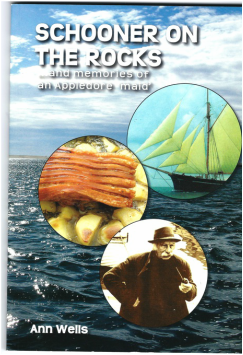 Ann's book available to buy in Appledore
Ann's book available to buy in Appledore
As
we talked, the sun dropped lower in the sky, the flood tide crept slowly in and
the fishing vessel we were watching moved towards us, waiting for the chance to
cross the bar. “Dad wouldn’t recognise it now,” she said, referring to the
changes in the river, after the winter storms. “We used to see the edge of
Pulleys, now it’s disappeared.” She spoke of Zulu banks named after a
shipwreck, Canons named after the canons which used to guard the estuary and Sprat
ridge where she dug for sprats or sand eels. Evocative names I’m getting used
to having spoken to many fishermen on the river, these last few months. Ann
could tell fascinating tales on into the night. To discover more I recommend
her books, ‘Schooner on the Rocks’ and ‘Appledore Rope Mats’ available
from Appledore news and Walter Henry's bookshop in Bideford.
Ann showed me traditional mats made from sailor’s hemp, sole skins which were fashioned to bait sea bass and then finally we went outside in the garden to see the Puffin. “A large salmon is waiting to jump into my boat,” Ann told me, with another lovely peal of laughter.
Ann showed me traditional mats made from sailor’s hemp, sole skins which were fashioned to bait sea bass and then finally we went outside in the garden to see the Puffin. “A large salmon is waiting to jump into my boat,” Ann told me, with another lovely peal of laughter.

